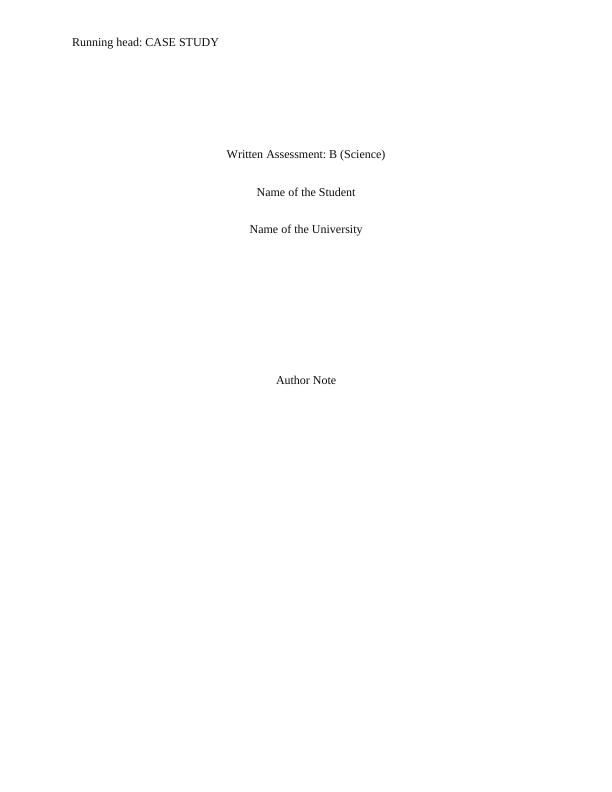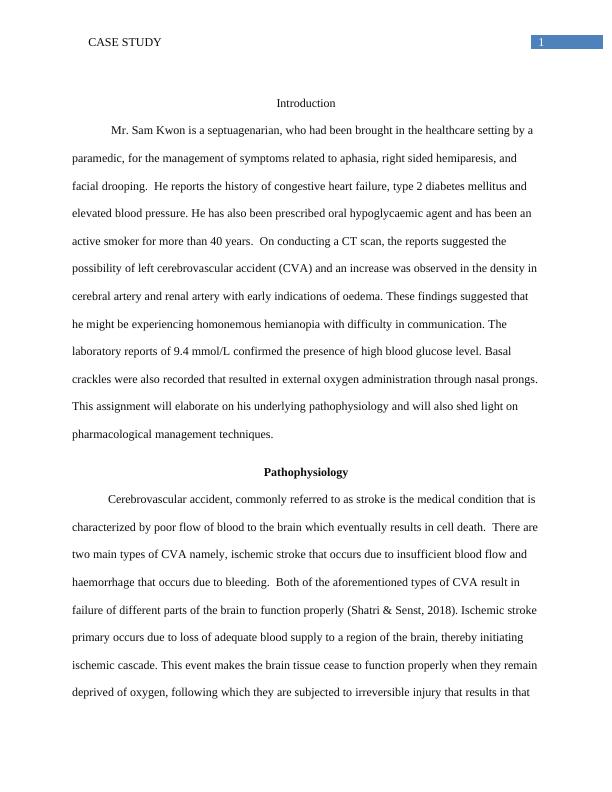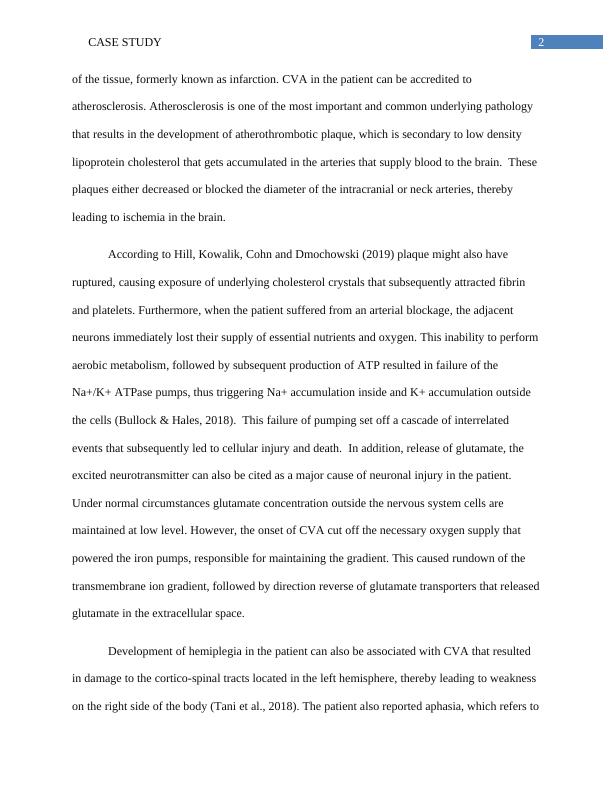Written Assessment Case Study 2022
Added on 2022-10-04
11 Pages2688 Words15 Views
Running head: CASE STUDY
Written Assessment: B (Science)
Name of the Student
Name of the University
Author Note
Written Assessment: B (Science)
Name of the Student
Name of the University
Author Note

1CASE STUDY
Introduction
Mr. Sam Kwon is a septuagenarian, who had been brought in the healthcare setting by a
paramedic, for the management of symptoms related to aphasia, right sided hemiparesis, and
facial drooping. He reports the history of congestive heart failure, type 2 diabetes mellitus and
elevated blood pressure. He has also been prescribed oral hypoglycaemic agent and has been an
active smoker for more than 40 years. On conducting a CT scan, the reports suggested the
possibility of left cerebrovascular accident (CVA) and an increase was observed in the density in
cerebral artery and renal artery with early indications of oedema. These findings suggested that
he might be experiencing homonemous hemianopia with difficulty in communication. The
laboratory reports of 9.4 mmol/L confirmed the presence of high blood glucose level. Basal
crackles were also recorded that resulted in external oxygen administration through nasal prongs.
This assignment will elaborate on his underlying pathophysiology and will also shed light on
pharmacological management techniques.
Pathophysiology
Cerebrovascular accident, commonly referred to as stroke is the medical condition that is
characterized by poor flow of blood to the brain which eventually results in cell death. There are
two main types of CVA namely, ischemic stroke that occurs due to insufficient blood flow and
haemorrhage that occurs due to bleeding. Both of the aforementioned types of CVA result in
failure of different parts of the brain to function properly (Shatri & Senst, 2018). Ischemic stroke
primary occurs due to loss of adequate blood supply to a region of the brain, thereby initiating
ischemic cascade. This event makes the brain tissue cease to function properly when they remain
deprived of oxygen, following which they are subjected to irreversible injury that results in that
Introduction
Mr. Sam Kwon is a septuagenarian, who had been brought in the healthcare setting by a
paramedic, for the management of symptoms related to aphasia, right sided hemiparesis, and
facial drooping. He reports the history of congestive heart failure, type 2 diabetes mellitus and
elevated blood pressure. He has also been prescribed oral hypoglycaemic agent and has been an
active smoker for more than 40 years. On conducting a CT scan, the reports suggested the
possibility of left cerebrovascular accident (CVA) and an increase was observed in the density in
cerebral artery and renal artery with early indications of oedema. These findings suggested that
he might be experiencing homonemous hemianopia with difficulty in communication. The
laboratory reports of 9.4 mmol/L confirmed the presence of high blood glucose level. Basal
crackles were also recorded that resulted in external oxygen administration through nasal prongs.
This assignment will elaborate on his underlying pathophysiology and will also shed light on
pharmacological management techniques.
Pathophysiology
Cerebrovascular accident, commonly referred to as stroke is the medical condition that is
characterized by poor flow of blood to the brain which eventually results in cell death. There are
two main types of CVA namely, ischemic stroke that occurs due to insufficient blood flow and
haemorrhage that occurs due to bleeding. Both of the aforementioned types of CVA result in
failure of different parts of the brain to function properly (Shatri & Senst, 2018). Ischemic stroke
primary occurs due to loss of adequate blood supply to a region of the brain, thereby initiating
ischemic cascade. This event makes the brain tissue cease to function properly when they remain
deprived of oxygen, following which they are subjected to irreversible injury that results in that

2CASE STUDY
of the tissue, formerly known as infarction. CVA in the patient can be accredited to
atherosclerosis. Atherosclerosis is one of the most important and common underlying pathology
that results in the development of atherothrombotic plaque, which is secondary to low density
lipoprotein cholesterol that gets accumulated in the arteries that supply blood to the brain. These
plaques either decreased or blocked the diameter of the intracranial or neck arteries, thereby
leading to ischemia in the brain.
According to Hill, Kowalik, Cohn and Dmochowski (2019) plaque might also have
ruptured, causing exposure of underlying cholesterol crystals that subsequently attracted fibrin
and platelets. Furthermore, when the patient suffered from an arterial blockage, the adjacent
neurons immediately lost their supply of essential nutrients and oxygen. This inability to perform
aerobic metabolism, followed by subsequent production of ATP resulted in failure of the
Na+/K+ ATPase pumps, thus triggering Na+ accumulation inside and K+ accumulation outside
the cells (Bullock & Hales, 2018). This failure of pumping set off a cascade of interrelated
events that subsequently led to cellular injury and death. In addition, release of glutamate, the
excited neurotransmitter can also be cited as a major cause of neuronal injury in the patient.
Under normal circumstances glutamate concentration outside the nervous system cells are
maintained at low level. However, the onset of CVA cut off the necessary oxygen supply that
powered the iron pumps, responsible for maintaining the gradient. This caused rundown of the
transmembrane ion gradient, followed by direction reverse of glutamate transporters that released
glutamate in the extracellular space.
Development of hemiplegia in the patient can also be associated with CVA that resulted
in damage to the cortico-spinal tracts located in the left hemisphere, thereby leading to weakness
on the right side of the body (Tani et al., 2018). The patient also reported aphasia, which refers to
of the tissue, formerly known as infarction. CVA in the patient can be accredited to
atherosclerosis. Atherosclerosis is one of the most important and common underlying pathology
that results in the development of atherothrombotic plaque, which is secondary to low density
lipoprotein cholesterol that gets accumulated in the arteries that supply blood to the brain. These
plaques either decreased or blocked the diameter of the intracranial or neck arteries, thereby
leading to ischemia in the brain.
According to Hill, Kowalik, Cohn and Dmochowski (2019) plaque might also have
ruptured, causing exposure of underlying cholesterol crystals that subsequently attracted fibrin
and platelets. Furthermore, when the patient suffered from an arterial blockage, the adjacent
neurons immediately lost their supply of essential nutrients and oxygen. This inability to perform
aerobic metabolism, followed by subsequent production of ATP resulted in failure of the
Na+/K+ ATPase pumps, thus triggering Na+ accumulation inside and K+ accumulation outside
the cells (Bullock & Hales, 2018). This failure of pumping set off a cascade of interrelated
events that subsequently led to cellular injury and death. In addition, release of glutamate, the
excited neurotransmitter can also be cited as a major cause of neuronal injury in the patient.
Under normal circumstances glutamate concentration outside the nervous system cells are
maintained at low level. However, the onset of CVA cut off the necessary oxygen supply that
powered the iron pumps, responsible for maintaining the gradient. This caused rundown of the
transmembrane ion gradient, followed by direction reverse of glutamate transporters that released
glutamate in the extracellular space.
Development of hemiplegia in the patient can also be associated with CVA that resulted
in damage to the cortico-spinal tracts located in the left hemisphere, thereby leading to weakness
on the right side of the body (Tani et al., 2018). The patient also reported aphasia, which refers to

3CASE STUDY
inability to formulate of comprehend language, owing to damage to particular brain regions,
caused by the CVA. Insufficient flow of blood to the language area of the brain, particularly the
Broca’s area resulted in aphasia and made it difficult for the patient to communicate (Teleb, Ver
Hage, Carter, Jayaraman & McTaggart, 2017). Basal crackles can be attributed to either
accumulation of fluid or mucus in the lungs or failure of different portions of the lungs to inflate
in a proper manner due to inflammation (Douros, Grammeniatis & Loukou, 2018). High blood
glucose level occurred due to insufficient production of insulin hormone from the beta cells,
leading to the onset of insulin resistance. This resulted in inability of the cells to adequately
respond to normal insulin level, thus triggering the inappropriate release of glucose into
circulating bloodstream from the liver. This in turn increased the blood glucose level and
resulted in diagnosis of type 2 diabetes mellitus (Zaccardi, Webb, Yates & Davies, 2016).
Pharmacological management
The risk of stroke can be reduced to the administration of aspirin. According to Cadavid
(2017) this medication suppresses the production of thromboxane and prostaglandin by
irreversible cyclooxygenase inactivation. The aforementioned enzyme is required for synthesis
of thromboxane and prostaglandin. Administration of low dose (40 mg) of aspirin will result in
irreversible block of thromboxane-A2 formation in the platelet, thus creating an inhibitory
impact on platelet aggregation. This mechanism of action of the drug can be associated with the
fact that COX 2 inhibitors have been found to increase the likelihood of a person to suffer from
heart attack. Taking into consideration the fact that platelets do not have any DNA, they will not
be able to synthesise new COX, following the irreversible inhibition, thus proving effective in
management of CVA.
inability to formulate of comprehend language, owing to damage to particular brain regions,
caused by the CVA. Insufficient flow of blood to the language area of the brain, particularly the
Broca’s area resulted in aphasia and made it difficult for the patient to communicate (Teleb, Ver
Hage, Carter, Jayaraman & McTaggart, 2017). Basal crackles can be attributed to either
accumulation of fluid or mucus in the lungs or failure of different portions of the lungs to inflate
in a proper manner due to inflammation (Douros, Grammeniatis & Loukou, 2018). High blood
glucose level occurred due to insufficient production of insulin hormone from the beta cells,
leading to the onset of insulin resistance. This resulted in inability of the cells to adequately
respond to normal insulin level, thus triggering the inappropriate release of glucose into
circulating bloodstream from the liver. This in turn increased the blood glucose level and
resulted in diagnosis of type 2 diabetes mellitus (Zaccardi, Webb, Yates & Davies, 2016).
Pharmacological management
The risk of stroke can be reduced to the administration of aspirin. According to Cadavid
(2017) this medication suppresses the production of thromboxane and prostaglandin by
irreversible cyclooxygenase inactivation. The aforementioned enzyme is required for synthesis
of thromboxane and prostaglandin. Administration of low dose (40 mg) of aspirin will result in
irreversible block of thromboxane-A2 formation in the platelet, thus creating an inhibitory
impact on platelet aggregation. This mechanism of action of the drug can be associated with the
fact that COX 2 inhibitors have been found to increase the likelihood of a person to suffer from
heart attack. Taking into consideration the fact that platelets do not have any DNA, they will not
be able to synthesise new COX, following the irreversible inhibition, thus proving effective in
management of CVA.

End of preview
Want to access all the pages? Upload your documents or become a member.
Related Documents
Exploration of a Pathophysiology Caselg...
|8
|2386
|201
Pathophysiology and pharmacology of cerebrovascular accident: A case studylg...
|10
|2676
|244
Cerebrovascular Accident: Pathophysiology and Pharmacologic Managementlg...
|10
|2402
|241
Nursing Pathophysiology Case Study 2022lg...
|16
|4732
|14
Cerebrovascular Accident Assignment 2022lg...
|4
|461
|36
Cerebrovascular Accident and Nursing Carelg...
|5
|539
|140